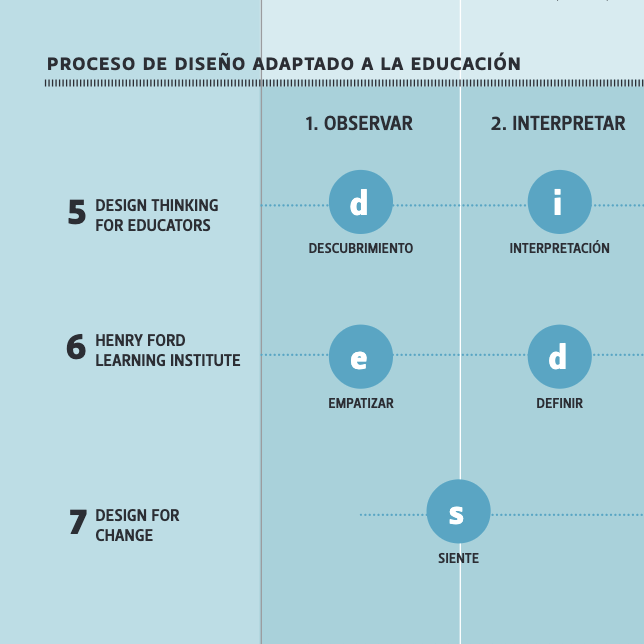Analogías visuales Representación del proceso de diseño y su aplicación en el ámbito de la educación
Contenido principal del artículo
Resumen
En los últimos años, el design thinking o el pensamiento de diseño ha sido comprendido y difundido como un método de resolución creativa de problemas, para ser utilizado por profesionales de otras disciplinas. Ello, con el propósito de estimular el pensamiento creativo en la identificación de problemas y en el desarrollo de soluciones (Johansson-Sköldberg et al., 2013; Dost, 2011; Hassi & Laakso, 2011).
Detalles del artículo
Citas
Alexander, C., (1964), Notes on the Synthesis of Form (Vol. 5), Boston, USA: Harvard University Press.
Caroll, M., (2015), Stretch, Dream, and Do-A 21st Century Design Thinking & STEM Journey, Journal of Research in STEM Education, 1(1), 3-16.
Cross, N., (1999), Métodos de diseño: estrategias para el diseño de productos, México: Limusa.
Cross, N., (2011), Design Thinking: Understanding How Designers Think and Work, UK: Berg Publishers.
Design for Change. Extraído el 1 de junio de 2016 desde: http://www.dfcworld.com
Design for Change España. Extraído el 1 de junio de 2016 desde: http://www.dfcspain.com
Design for Change Chile. Extraído el 1 de junio de 2016 desde: http://dfcchile.cl
Design Council (2014). Innovation by design. How design enables science and technology research to achieve greater impact. Extraído desde http://www.designcouncil.org.uk/sites/default/files/asset/document/innovation-by-design.pdf
Dorst, K., (2011), The core of ‘design thinking’and its application, Design studies, 32(6), 521-532.
Dorst, K., & Cross, N., (2001), Creativity in the design process: co-evolution of problem–solution, Design studies, 22(5), 425-437.
Dubberly, H., (2004), How do you design? San Francisco, USA: Dubberly Design Office.
Dubberly, H., & Evenson, S., (2008), On modeling The analysis-synthesis bridge model, interactions, 15(2), 57-61.
Dubberly, H., & Evenson, S., (2011), Design as learning---or knowledge creation---the SECI model, interactions, 18(1), 75-79.
FabLab Teacher Studio. Project Planing Document. Extraído el 1 de junio de 2016 desde: https://sites.google.com/site/stemfabstudio/minicourse/1172011-11112011
Hassi, L., & Laakso, M., (2011, October), Conceptions of Design Thinking in the design and management discourses. In Proceedings of IASDR2011, the 4th World Conference on Design Research, Delft (pp. 1-10).
Henry Ford Learning Institute. HFLI´s Design Thinking Model. Extraído el 1 de julio de 2016 desde: http://hfli.org/redesigning-how-we-learn/
Ideo (2012) Design Thinking for Educators. Extraído el 1 de julio de 2016 desde: http://www.designthinkingforeducators.com/
Ideo, BMGF, IDE, Heifer International & ICRW .,(2009), Design Kit Human- Centered Design Toolkit, IDEO.
Johansson-Sköldberg, U., Woodilla, J., & Çetinkaya, M., (2013), Design thinking: past, present and possible futures, Creativity and Innovation Management, 22(2), 121-146.
Kangas, K., Seitamaa-Hakkarainen, P., & Hakkarainen, K., (2013), Design thinking in elementary students’ collaborative lamp designing process, Design and Technology Education: An International Journal, 18(1).
Kelley, T., & Kelley, D., (2013), Creative confidence: Unleashing the creative potential within us all, USA: Crown Business.
Kumar, V., (2012), 101 design methods: A structured approach for driving innovation in your organization, John Wiley & Sons.
Munari, B., & Rodríguez, C. A., (1983), ¿Cómo nacen los objetos?, México Gustavo Gili.
Rittel, H. W., & Webber, M. M., (1973), Dilemmas in a general theory of planning, Policy Sciences, 4(2), 155-169.
Scheer, A., Noweski, C., & Meinel, C., (2012), Transforming constructivist learning into action: Design thinking in education, Design and Technology Education: An International Journal, 17(3).
Watson, A. D., (2015), Design Thinking for Life, Art Education, 68(3), 12-18.


